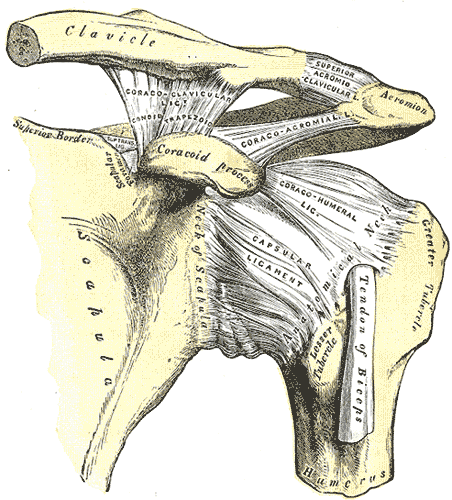◔
Acromioclavicular Joint
From WikiMSK
This article is a stub.

| |
| Acromioclavicular Joint | |
|---|---|
| Primary Type | Synovial Joint |
| Secondary Type | Planar Joint |
| Bones | Scapula, Clavicle |
| Feature | Fibrocartilaginous wedge-shaped disc. |
| Ligaments | Coracoclavicular, coracoacromial, superior acromioclavicular, and inferior acromioclavicular ligaments. |
| Muscles | No muscles directly act on this joint. |
| Innervation | Axillary, suprascapular, and lateral pectoral nerves |
| Vasculature | Suprascapular and thoracoacromial arteries |
| ROM | Upward rotation: 30 degrees, external rotation:8 degrees |
| Volume | 2mL |
| Conditions | Acromioclavicular Joint Osteoarthritis, Acromioclavicular Joint Injury |
The acromioclavicular joint (ACJ) is formed by the junction between the acromion process of the scapula and the distal clavicle. It is a plane synovial joint and forms part of the shoulder girdle (ACJ, GHJ, and SCJ). It can include a fibrocartilaginous disk
Range of Motion
There is significant motion at the ACJ during elevation of the humerus.(See Shoulder Biomechanics).[1]
References
- ↑ Teece, Rachael M.; Lunden, Jason B.; Lloyd, Angela S.; Kaiser, Andrew P.; Cieminski, Cort J.; Ludewig, Paula M. (2008-04). "Three-dimensional acromioclavicular joint motions during elevation of the arm". The Journal of Orthopaedic and Sports Physical Therapy. 38 (4): 181–190. doi:10.2519/jospt.2008.2386. ISSN 0190-6011. PMC 2759875. PMID 18434666. Check date values in:
|date=(help)

